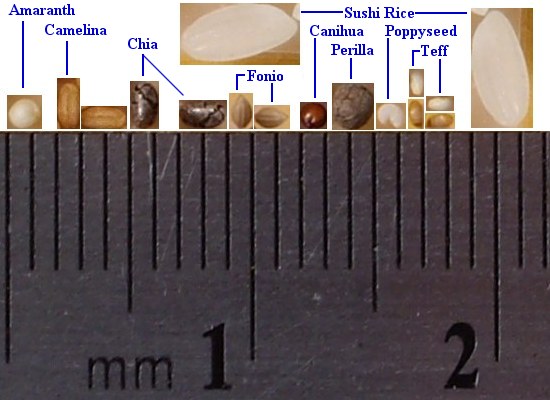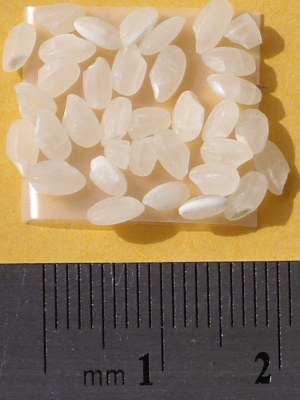photos and descriptions
[a work in progress]

| Small Seed Comparison - The photo of each seed is at the same scale as every other seed as well as at the scale of the ruler. The photo was enlarged for easier viewing of each seed. Sushi rice is a short grain rice used for comparison. You can see how much smaller all of these seeds are compared to the rice. Poppyseed was also included for comparison, since this is a common small seed. Kaniwa (canihua) seeds are not much different in size or shape from poppyseeds. Teff seeds (ivory teff above, brown teff below) are clearly smaller than any of the other seeds in the photo. Amaranth and Camelina are each grown commercially in the U.S., using conventional means, so larger seeds such as perilla and chia should also be viable crops. Teff poses the greatest challenge for growers in terms of seed size. |
 View larger image |
Amaranth - amaranth has round and slightly flattened seeds from 1.0 to 1.5 mm in diameter. The seeds vary in color; in this example, they are off-white -- lighter in color than ivory teff, but slightly darker than white poppy seeds (see below). For most grains, the marketplace prefers lighter colored (white or tan) seeds, which also tend to have a lighter taste. The reduction in tannins found in lighter grains may make the nutrition in the grain more accessible for digestion, since tannins are an anti-nutritional factor that bind to proteins.
Although the grains are small, production with conventional grain crop equipment is practical. Recommended seeding rate is only 2 lbs per acre, but seeding rates as low as 0.25 lbs per acre can produce acceptable yields (1000 or more lbs per acre). Harvesting amaranth is easier than with other grains, since each amaranth plant produces several ounces of grain. It is easier to cut a few large amaranth plants at harvest, rather than many shorter rice or wheat plants. And as a pseudo-cereal, amaranth grain has no hulls. After harvest, the grain is threshed (separated from the plant), cleaned and dried. No hulling or milling is necessary. In the developing world, amaranth would be an excellent crop to grow alongside the more common staple grains. Other grains require substantial manual labor to remove the hulls. Amaranth provides excellent nutritution with much less labor. Amaranth grain is a complete protein, with more total protein (13.56% per USDA Nutrient Database SR23) than many other grains, and sufficient percentages of each essential amino acid. |
 View larger image | Camelina - |
 View larger image | Chia - |
 View larger image |
Fonio - seeds are oblong, 1.5 to 2.0 mm in length and 1.0 mm or less in width, but not flattened like some other seeds. They are larger than poppyseeds and much larger than teff seeds, but smaller than chia or perilla seeds. Fonio seeds are about the same size as camelina seeds. In germination tests, fonio seeds sprouted in 48 to 60 hours. When planted, the first green seedlings appeared 3 to 4 days after planting.
Fonio planted 8 Oct 2010. The seedlings first appeared as one leaf on a very short stem (not two as in most seedlings). The second leaf emerged a day or two later. Subsequent leaves were added one at a time, on alternating sides of the stem, not two at a time as in many other plants. Photo taken on 23 Oct 2010 Fonio grain has a total amount of protein similar to rice, but with substantially less lysine. Fonio protein varies from about 7 to 9%, and lysine varies from 2.5% to about 2.9% of total protein. Rice typically has about 3.8% of its protein as lysine, giving rice 30% more lysine than fonio. |
 View larger image |
Kaniwa (canihua) - Kaniwa seeds were planted and watered on 9 Oct 2010; they sprouted in 3 days. The seedlings have long thin stems and a single pair of leaves. They fall over easily (lodge). In these photos, taken on 23 Oct 2010: Photo A | Photo B | Photo C, note that several seedlings have fallen over, and that each seedling adds pairs of leaves alternating at a 90 degree angle to the previous pair.
Canihua (kaniwa) grain is 14% protein, with a high lysine content of 5.9%, which is 116% of the ideal amount (5.1% is ideal). The grain also contains 4% fat and 52% carbohydrates (Food protein sources, Pirie et al.). |
 View larger image | Perilla - |
 View larger image | Teff, brown - Teff seeds are smaller than fonio, and are perhaps the smallest domesticated grain. In germination tests, brown teff germinated in only 24 hours. |
 View larger image |
Teff, ivory - Ivory teff is of similar size to brown teff. In germination tests, ivory teff germinated in 24 to 36 hours. When planted, the first green seedlings appeared within three days.
Planted 8 Oct 2010. The seedlings first appear as one long thin curved leaf, resembling a curved blade of grass, without an apparent stem. The second leaf, also resembling a blade of grass, emerges a day or two later, and curves in the opposite direction. The seedlings are sturdy, with a short stout stem, and do not lodge (fall over and become trapped against the soil) easily. Subsequent leaves are added one at a time, on alternating sides of the stem, not two at a time as in many other plants. Photo taken on 23 Oct 2010. Teff grain has a total amount of protein (13.30%) similar to wheat (10 to 14%), and with about the same percentage of lysine (2.83%). |
 View larger image | Poppy seed (for comparison) |
 View larger image | Sushi rice (for comparison) |